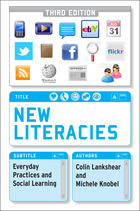Thursday, August 29, 2013
New book in our series: "Children's Virtual Play Worlds"
Loads of congratulations to Anne Burke and Jackie Marsh on the publication of their new edited collection, Children's Virtual Play Worlds: Culture, Learning and Participation!
From the back cover:
As children’s digital lives become more relevant to schools and educators, the question of play and learning is being revisited in new and interesting ways. Children’s Virtual Play Worlds: Culture, Learning, and Participation provides a more reasoned account of children’s play engagements in virtual worlds through a number of scholarly perspectives, exploring key concerns and issues which have come to the forefront. The global nature of the research in this edited volume embraces many different areas of study from school based research, sociology, cultural studies, psychology, to contract law showing how children’s play and learning in virtual spaces has great potential and possibilities.
Contents include:
Chapter 1: Anne Burke and Jackie Marsh: Introduction: The changing landscapes of children’s play worlds
Chapter 2: Susan Edwards: Post-industrial play: Understanding the relationship between traditional and converged forms of play in the early years
Chapter 3: Kaveri Subrahmanyam: Developmental implications for children’s virtual worlds
Chapter 4: Anne Burke: Stardolls and the virtual playground: How identity construction works in the new digital frontier
Chapter 5: Jackie Marsh: Breaking the ice: Play, friendships and online identities in young children’s use of virtual worlds
Chapter 6:Karen E. Wohlwend and Tolga Kargin: «Cause I know how to get friends - plus they like my dancing»: (L)earning the Nexus of Practice in Club Penguin
Chapter 7: Jan Connelly: Virtual clay or virtual play: Identity shaping, consumer building and corporate affiliation versus literacies affordance inside barbiegirls.com
Chapter 8: Isabel Pederson and Jennifer Rowsell: May the force be with you: Harnessing the power of brain-computer games
Chapter 9: Stephanie M. Reich, Ksenia A. Korobkova, Rebecca W. Black and Mariya Sumaroka: «Hey! Can you show me how to do this?» Digital games as a mediator of family time
Chapter 10: Sara M. Grimes: Digital play structures: Examining the terms of use (and play) found in children’s commercial virtual worlds
Chapter 12: Eric Meyers and Robert Bittner: Green pixels to green behaviours: Sustainability literacy in virtual worlds for children
Chapter 13: Victoria Carrington: An argument for assemblage theory: Integrated spaces, mobility, and polycentricity.
Afterword: Jackie Marsh and Anne Burke









